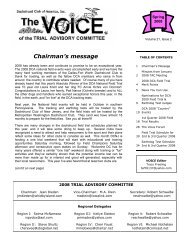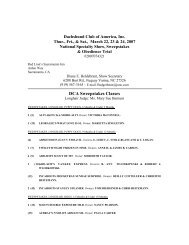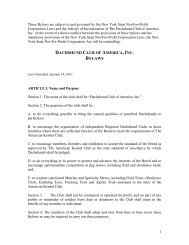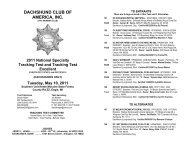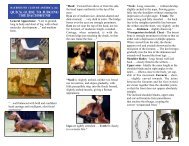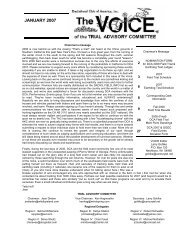Hope for IVDD Dogs - The Dachshund Club of America, Inc.
Hope for IVDD Dogs - The Dachshund Club of America, Inc.
Hope for IVDD Dogs - The Dachshund Club of America, Inc.
You also want an ePaper? Increase the reach of your titles
YUMPU automatically turns print PDFs into web optimized ePapers that Google loves.
Rhea’s Story<br />
By Lynne Dahlén<br />
Determination and perseverance should be<br />
Rhea’s registered name! Chazlyn’s Purely<br />
Providence SL was placed in pet home<br />
when she was 4 years old. She was shown a few<br />
times in the first four years she was with us,<br />
pointed, but I wasn’t thrilled with her rear<br />
movement and decided we shouldn’t breed her.<br />
She loved people, but was also one <strong>of</strong> those<br />
girls who wanted badly to be the “alpha bitch”<br />
http://youtu.be/VDBCSq2JOLU<br />
SAVING DOGS<br />
WITH SPINAL<br />
CORD INJURIES<br />
ScienceDaily (Jan. 18, 2012) — <strong>Dogs</strong> with spinal cord injuries may soon<br />
benefit from an experimental drug being tested by researchers at the<br />
University <strong>of</strong> Cali<strong>for</strong>nia, San Francisco (UCSF) and Texas A&M College <strong>of</strong><br />
Veterinary Medicine & Biomedical Sciences — work that they hope will<br />
one day help people with similar injuries.<br />
Funded through a three-year, $750,000 grant from the U.S. Department<br />
<strong>of</strong> Defense, the drug to mitigate damage has already proven effective in<br />
mice at UCSF. Now the Texas team will test how it works in previously<br />
injured short-legged, long torso breeds <strong>of</strong> dog like dachshunds, beagles<br />
and corgis, who <strong>of</strong>ten suffer injuries when a disk in their back<br />
spontaneously ruptures, damaging the underlying spinal cord.<br />
About 120 dogs a year that develop sudden onset hind limb paralysis<br />
after such injuries are brought to the Small Animal Hospital <strong>of</strong> Texas<br />
A&M University, where they receive surgical and medical treatment<br />
similar to that <strong>for</strong> human spinal cord injury. Now, researchers will test<br />
whether the new treatment works on some <strong>of</strong> these dogs, with their<br />
owners’ consent.<br />
“It would be phenomenal if it works,” said Linda J. Noble-Haeusslein,<br />
PhD, a pr<strong>of</strong>essor in the UCSF departments <strong>of</strong> Neurological Surgery and<br />
Physical <strong>The</strong>rapy and Rehabilitation Science who designed the<br />
intervention. “We are in a unique position <strong>of</strong> being able to treat a dog<br />
population where there are simply no current therapies that could<br />
effectively improve their hind limb function.”<br />
<strong>The</strong> new treatment does not seek to regrow injured pathways in the<br />
spinal cord. Instead, it aims to mitigate damage secondary to the spinal<br />
cord injury. Most spinal cord injuries trigger a cascade <strong>of</strong> chemical<br />
reactions in the spinal cord that collectively damage nearby cells and<br />
with the other girls in my pack. <strong>The</strong>y had<br />
different ideas. She was spending far too much<br />
time in her crate and, as gut-wrenching as it<br />
was to part with her, I felt she would be far<br />
happier as an “only” dog. She was spayed be<strong>for</strong>e<br />
she was placed.<br />
Fast <strong>for</strong>ward 4 years - I received a call from a<br />
friend saying 8 year old Rhea had gone down.<br />
Un<strong>for</strong>tunately, her owner didn’t call me<br />
immediately and we lost valuable treatment<br />
time. To make an extremely long story fairly<br />
short, the owner couldn’t af<strong>for</strong>d surgery and was<br />
not able to cope with a disabled dog. I owe a big<br />
thank you to many friends, and vets almost 300<br />
miles away who helped Rhea<br />
get proper treatment. After<br />
assesments by 4 different vets,<br />
my friend and also a vet, Dr.<br />
Peggy Orzel, brought Rhea to<br />
the Fox Valley Referral Center<br />
in Appleton, WI. <strong>The</strong> board<br />
certified surgeon, Dr. Bruce<br />
VanEnkevort, gave her an 85%<br />
chance <strong>of</strong> complete recovery<br />
after surgery to her C3 disk.<br />
<strong>The</strong> surgery went<br />
extremely well and<br />
the recovery was<br />
remarkable. Rhea<br />
was standing within<br />
48 hours after the<br />
<strong>Dachshund</strong> <strong>Club</strong> <strong>of</strong> <strong>America</strong> 73 SPRING, 2012<br />
surgery. 4 days later, Rhea’s breeder, Ellen<br />
Weiland, transported Rhea half way across the<br />
state where I picked her up and returned home<br />
to northern Wisconsin. Within just a few days<br />
she was attempting to walk, and she returned to<br />
normal quickly after minimal walking therapy.<br />
That was in February <strong>of</strong> 2011. A year later<br />
Rhea is running and playing (her buddies now<br />
are our 13 year old male Lhasa rescue and our<br />
little black house cat). We keep her separate<br />
from our other dachsies to avoid any “issues” (so<br />
much <strong>for</strong> no dogs upstairs!) One would never<br />
know she wasn’t able to walk at one time.<br />
As Cris stated, <strong>IVDD</strong> is not a death sentence<br />
and with education and proper care, our dogs<br />
can go on to live happy, healthy and long lives.<br />
Surgery is not the only option.<br />
As breeders, we all try to do our best to breed<br />
away from known back issues, but I’m sure the<br />
great majority <strong>of</strong> us who have had more than a<br />
few litters have had to deal with <strong>IVDD</strong> at one<br />
time or another. Rhea was the first in our 25<br />
years <strong>of</strong> limited breeding that has had a disc<br />
problem not attributed to an injury. Luckily, she<br />
never had puppies. Surgery is not the only<br />
option - but knowing where to find the resources<br />
to help a disabled pet is the first step. A<br />
Dodgerslist brochure should be included in each<br />
and every puppy packet we give to our new<br />
puppy owners.<br />
http://www.dodgerslist.com/<br />
pathways, contributing to functional deficits including hind limb function.<br />
A few years ago, Noble and her UCSF colleague Zena Werb, PhD,<br />
showed how blocking the action <strong>of</strong> one protein found in the spinal cord <strong>of</strong><br />
mammals can help mice recover from spinal cord injuries. This protein,<br />
called matrix metalloproteinase-9, can degrade pathways within the cord<br />
and cause local inflammation, leading to cell death.<br />
<strong>The</strong> injured dogs <strong>of</strong>fer a great opportunity to take the next step on this<br />
treatment because their injuries more closely mimic spontaneous human<br />
spinal cord injury and, as is the case with humans, no existing treatment<br />
has substantially reduced paralysis.<br />
Noble’s co-investigator on the new study, Jonathan Levine, DVM, an<br />
assistant pr<strong>of</strong>essor in neurology at Texas A&M University, will treat the<br />
dogs through injections <strong>of</strong> a protein-blocking drug. He will then help the<br />
dogs through rehabilitation and assess their recovery. Ongoing studies at<br />
UCSF focus on further refining delivery <strong>of</strong> the drug so as to optimize<br />
recovery.<br />
Other researchers have shown that movement can be preserved if as<br />
little as 18 percent to 20 percent <strong>of</strong> the nerve fiber tracts in the spinal<br />
cord remain intact.<br />
If successful, the trials in injured dogs may lead to the development <strong>of</strong><br />
similar treatments <strong>for</strong> people who suffer spinal cord injuries, Noble said.<br />
<strong>The</strong>se are among the most expensive injuries: every person with an<br />
injured spinal cord costs the health care system millions <strong>of</strong> dollars over<br />
his or her lifetime.<br />
Such costs <strong>of</strong>ten are overshadowed by the tragic and devastating<br />
personal price <strong>of</strong> the injuries, which dramatically alter lives and most<br />
<strong>of</strong>ten occur in younger people, with long lives in front <strong>of</strong> them. According<br />
to the National Spinal Cord Injury Statistical Center, based at the<br />
University <strong>of</strong> Alabama, Birmingham, most <strong>of</strong> the 12,000 <strong>America</strong>ns who<br />
suffer spinal cord injuries are between the ages <strong>of</strong> 16 and 30.<br />
As <strong>of</strong> this year, some 265,000 people in the United States are living<br />
with such injuries, according to the national center. This includes many<br />
wounded soldiers who have returned home from war zones.<br />
UCSF is a leading university dedicated to promoting health worldwide<br />
through advanced biomedical research, graduate-level education in the life<br />
sciences and health pr<strong>of</strong>essions, and excellence in patient care.






